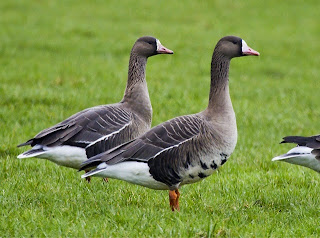Sooooo, it's 7.30am at a still-dark reservoir. The conditions are barbaric - close to zero, a scything north-westerly wind, driving icy rain, and a thin covering of snow underfoot. I'll be honest - at this point I am not a happy bunny.
But then, bang on cue, the honking of geese. There, exactly where expected in the fields between Farborough Bank and the sewage treatment plant, is a mixed flock of perhaps 300 geese. Mainly canada and greylag of course, but if I scan them closely enough...
 |
| The rather splendid Anser albifrons (photo: webted) |
And a few minutes later, while trying to relocate the pink-footed at the other end of the flock, I finally tracked down my second targets - a pair of white-fronted geese.
As ever, the weather and the early start and the sheer insanity of it all suddenly ceased to matter.
The pink-footed goose is of course splendid and rather uncommon in these parts (fields full of them in Norfolk of course, but that's not much good all the way over here). But the white-fronted is an even more marvellous proposition: beautifully black-striped across the belly at this time of year; pretty rare away from its normal wintering grounds (Slimbridge being perhaps the most important); and, most importantly on a morning like this, a county tick for yours truly.
I was on a roll, so perhaps I shouldn't have been so surprised at the way my third target came to hand.
For some reason the reports of pintail (numbers unknown) near the inlet had me looking for a striking (and unmissable) male bird out on the water. So I had reason to be grateful that I took the time to scan a small flock of female mallards at the water's edge, for it was here that I found the subtle and oh-so-easily-overlooked female pintail dabbling with her browner and more coarsely marked mallard sisters.
Any disappointment I may have felt in finding a greyish (if handsome) female in place of the stunning drake was soon dispelled by the nearby goosanders - good numbers of male and female birds, both striking of plumage, and another year tick.
Bird of the day: White-fronted goose (Anser albifrons), presumably (assuming not escapees from a collection) two of the Russian birds which would normally overwinter at Slimbridge.



